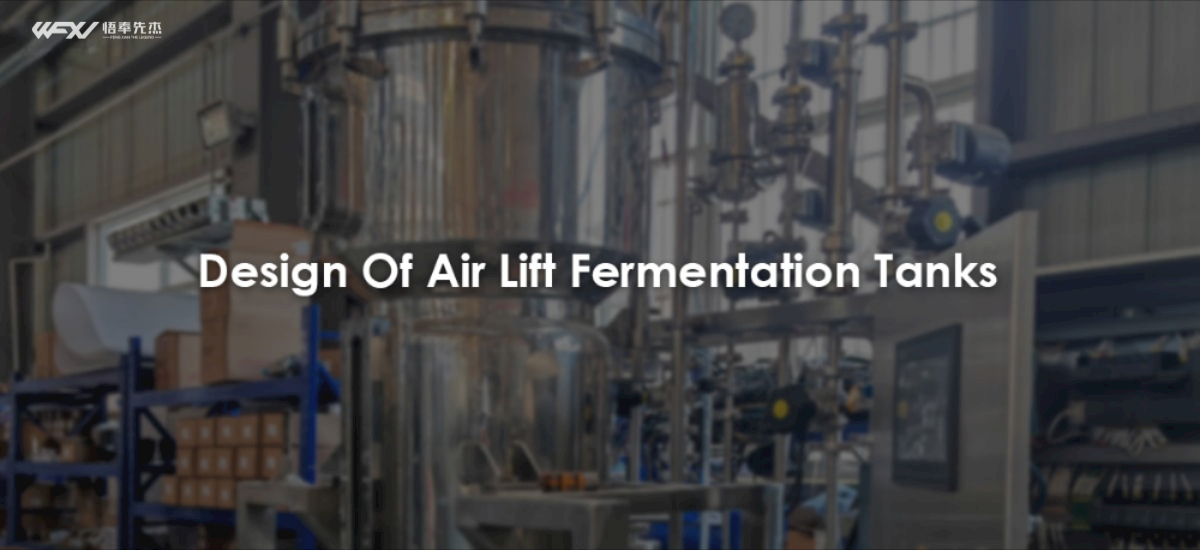
Airlift fermenters are the most widely used bioreactors. The airlift reactor is developed on the basis of the bubble tower reactor. It uses the injection function of air and the difference in fluid weight to cause the circulating flow of the reaction liquid to achieve stirring, mixing and oxygen transfer of the liquid. That is, there is no need for mechanical stirring, and it relies entirely on the lifting of the gas to cause circulation and turbulence of the liquid, thereby achieving the purpose of mixing and transferring gas and liquid.
Airlift bioreactor (ALR) structure
The airlift reactor has a relatively simple structure, does not require stirring, is easy to clean and maintain, is not susceptible to bacterial contamination, has low energy consumption, and has high oxygen-dissolving efficiency. At present, internal circulation air-lift fermentation tanks have been widely used in aerobic fermentation in the field of bioengineering, such as the culture of animal and plant cells, the culture of single-cell proteins, the culture of certain microbial cells, and sewage treatment. Products produced from this include single-cell proteins, alcohol, antibiotics, biosurfactants, etc.
Our country uses bioreactors to produce a large number of biological agents, and airlift cell culture bioreactors are mostly used. Airlift cell culture bioreactor is the abbreviation of air lift bioreactor.
Air lift fermentation tanks can be divided into internal circulation air lift fermentation tanks and external circulation air lift fermentation tanks according to the different liquid circulation methods they adopt. The former makes the rising tube and the falling tube in the circulation process both arranged inside the same fermentation tank; while the latter makes the rising tube and the falling tube arranged separately.
Airlift bioreactors mainly use internal circulation, but some also use external circulation. There are four components inside the internal circulation bioreactor:
(1) Liter hydraulic pressure is in the center of the reactor, inside the guide tube. If the air is sprayed at the bottom of the guide tube, due to the difference in hydrostatic pressure between the inside and outside of the tube, the gas-liquid mixed fluid will rise along the tube. After part of the gas is separated in the upper part of the reactor, it will fall along the pressure reducing tube again, forming a circular flow. If air is ejected at the bottom of the downcomer, the fluid circulation direction is exactly the opposite.
(2) Downdraft zone: the annular gap between the draft tube and the reactor wall. The fluid rises or falls along the downdraft zone, depending on the position of the injected air.
(3) The bottom area where the rising liquid zone is connected to the lower part of the downdraft zone has little impact on the reactor characteristics.
(4) The top area is the connecting area between the rising liquid area and the upper part of the falling liquid area. A gas-liquid separator can be installed at the top to remove liquid entrained in the exhaust gas.
In addition, the device is also equipped with an annular tube gas injector, etc.
During the circulation process, the gas and liquid achieve necessary mixing and stirring and obtain sufficient dissolved oxygen. The function of the jacket cooler is to adjust and control the temperature of the fermentation liquid in accordance with the process requirements at different fermentation stages. The porous plate ensures uniform air distribution.
The main applications of airlift reactors in the field of biotechnology are fermentation, wastewater treatment and biological cell culture. Due to the high viscosity, in order to improve the mass transfer rate, mechanical stirring tanks were often used for fermentation broth and biological cell culture fluid in the past.
In fact, as long as a suitable polymer is added to the medium and an airlift reactor is used, it can not only enhance mass transfer and increase production, but also reduce energy consumption.